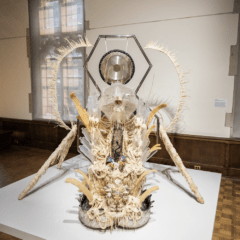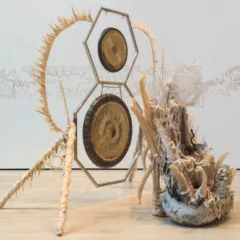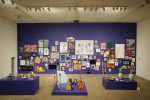Alexander Arrechea’s installation, Orange Tree, occupied Crane Arts‘ huge Icebox as well as the Grey Box leading to it from Jan. 21-Feb. 21, 2010, and it definitely held its ground within that vast space. Arrechea’s work, combining suggestions of menace and the high-tech production values of the latest Hollywood movie, rose to the challenge of the monumental scale. On entering the darkened Grey Box visitors were confronted with Black Sun (2009), a silent video projection of a swinging wrecking ball that marked time in the exhibition like a destructive pendulum.
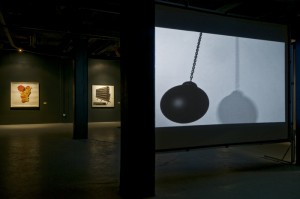
On the walls around it were three huge drawings and a digital print, all executed with tromp l’oeil virtuosity. Almohada (Pillow) (2005) and T-Shirt (2005) are watercolors depicting vastly-enlarged versions of the named objects, bound with measuring tape. I can’t say exactly why the form of the bound pillow evoked a trussed corpse, but the association was undeniable (I made me think of David Hammons ). Birds (2009) is a c-print referring to the camera-bearing tree in Garden of Mistrust, a video projection in the large space beyond. It creates the illusion of a piece of marbleized paper cut into the silhouette of the tree and pinned to a black background.
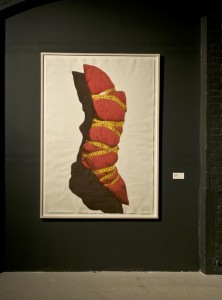
The Icebox space contained Orange Tree (2010), a towering, multi-limbed “tree” sprouting nineteen basketball hoops, rather than branches, surrounded by balls which looked liked fallen fruit. Facing it was a similar-sized video projection of Garden of Mistrust (2007), an earlier “tree” with constantly-moving video surveillance cameras substituting for branches. Both are obviously urban species, and strange mutations. If the increasing use of cameras is a way of keeping urban youth under control, basketball is one route they take to make their way within and out of the ghetto. It is unclear whether basketball will empower these players or ensnare them in the corporate control of professional sports.
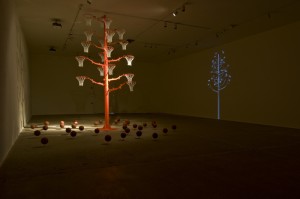
Arrechea’s world is one of illusion, often invoked in the name of power. The mutant forms and shifting scale create an intentional unease. He has previously dealt with the equipment and spaces of sports, those arenas and stadiums where boys and men play out their manhood, where symbolic wars are fought and national passions aroused. Raised within the state control of Castro’s Cuba, Arrechea is sensitive to the control that corporate power and fear have imposed on more open states in Europe and America. The project, curated by Anabelle Rodriguez, was the first in the International Curatorial Exchange at Crane Building, and a roaring start it was.
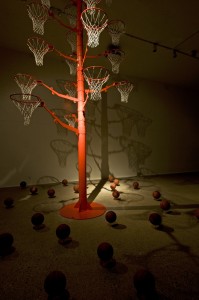
Miller Lagos’ Silence Doogood at the Arthur Ross Gallery, U. of Pennsylvania

Miller Lagos’ Silence Doogood at the Arthur Ross Gallery (the title was one of Benjamin Franklin’s pen names) through March 21, 2010 is the product of the artist’s residency at the University of Pennsylvania, and one of the independent projects of Philagrafika He worked with fine arts students to paste a ton of newspaper pages together and wind them into a huge roll which he sculpted to resemble a cross-section of a huge tree, although I needed to read the label copy to discover that. The gallery also contains stacks of newspapers sitting in the form a cube; walking around the pile the visitor discovers that a group of paper has been removed, resulting in a shape that reads as a throne (a sort of ur throne that a child might make). A video of Lagos working with the students and a short introduction by Lynn D. Marsden-Atlass, director of the gallery and Jose Roca, curator of Philagrafika, is shown beside the entrance. It can be seen on Youtube . .
Miller Lagos is clearly a charismatic teacher and the project appears to have been a pedagogic success. Jose Roca remarked that Lagos’ work reminds us that paper comes from trees; if the students hadn’t learned that in grade school, it was probably a useful lesson. They clearly saw the power of one artist to transform materials and gained experience with the shared vision and coordinated work required by such labor-intensive art, which they could never attempt within an educational system marked by semesters. The final product, however, was a bit thin as a gallery presentation. That’s a shame, because Lagos’ previous work sculpted from recycled newspaper is very impressive. The notion that the work deals with the dissemination of knowledge via newspapers may have been impressed upon the student collaborators, but did not come through as a significant focus in the work on display.



